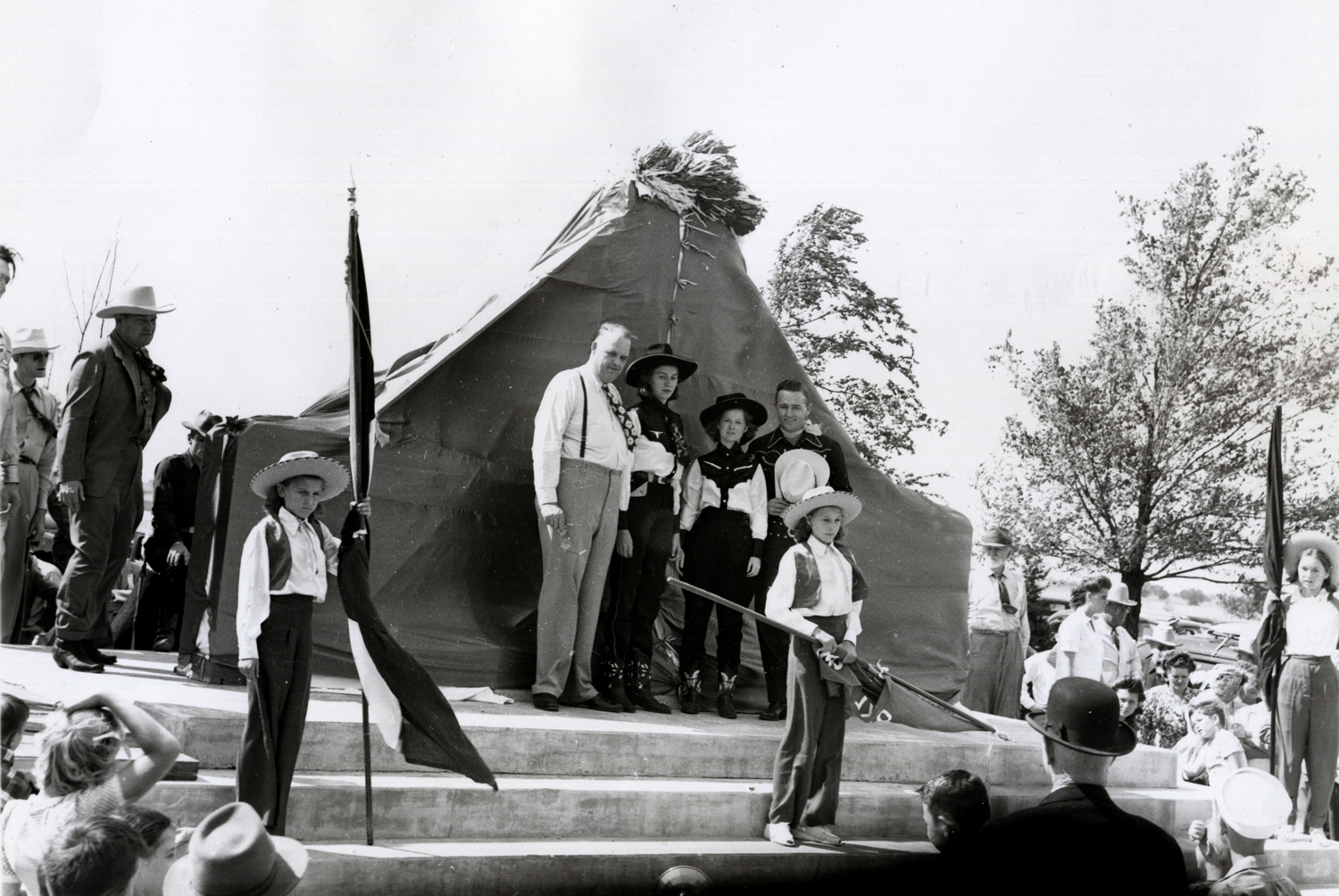
CHISHOLM TRAIL.
In its time, the Chisholm Trail was considered to be one of the wonders of the western world. Herds with as many as ten thousand cattle were driven from Texas over the trail to Kansas. The trail acquired its name from trader Jesse Chisholm, a part-Cherokee, who just before the Civil War had built a trading post in what is now western Oklahoma City. Black Beaver, a Delaware Indian scout and friend of Chisholm, had led Union soldiers north into Kansas along part of the route after the federal government abandoned Indian Territory to the Confederates at the beginning of the Civil War.
During the Civil War, while many Texans were away fighting for the Confederacy, the cattle multiplied. By 1866 they were only worth four dollars per head in Texas. In the North and East they could be worth forty dollars per head. In 1866 some herds traveled the Shawnee Trail in eastern Oklahoma, but the woods and the region's rough terrain discouraged trail driving.
In 1867 Joseph McCoy built stockyards on the Kansas-Pacific railroad in Abilene, Kansas. He sent men south to encourage Texas cattlemen to send herds to his stockyards. He also encouraged cattle buyers to come to Abilene, where cattle would be waiting. Drovers followed assorted minor trails through south and central Texas northward to the Red River crossing and then joined the Abilene Cattle Trail, which later became famous as the Chisholm Trail. It was so named at least by 1870 for trader Jesse Chisholm, who had operated a ranch near Wichita, Kansas, during the war. After being driven north along the Chisholm Trail to Abilene, the cattle were shipped east to the beef packers.
Herds varied in size from five hundred to ten thousand; however, they usually averaged from 2,500 to 3,000 head. A rancher entrusted his herd to a trail boss, who would hire ten to fourteen cowboys, a cook and wagon, and a wrangler (horse handler) for the 100 to 150 horses. The trail boss would also provision the wagon and plan the drive.
On the trail the cattle were watered in the morning, and then they slowly ate their way northward. The cowboys kept them from stopping, turning back, or leaving the herd. The herd would walk about ten miles per day, stopping only to water and eat. At night the herd would stop at a watering hole and bed down. These herds were less than ten miles apart and were spaced so that each herd could spend the night at a watering point. As a result of this spacing, if any problems occurred, the herds could stack up and time or cattle might be lost. At the Abilene railhead the trail boss would sell the cattle and horses, pay the cowboys, and return to Texas with the money for the owner, often repeating the trip year after year.
Eventually the Chisholm Trail would stretch eight hundred miles from South Texas to Fort Worth and on through Oklahoma to Kansas. The drives headed for Abilene from 1867 to 1871; later Newton and Wichita, Kansas became the end of the trail. The Cimarron cutoff on the north side of the Cimarron River allowed cattle to be driven to Dodge City, Kansas. From 1883 to 1887 herds headed up the trail to Caldwell, Kansas, making it the last great cow town on the trail.
The Chisholm Trail crossed from Texas over into Indian Territory at Red River Station, near present Ringgold, Texas, heading north. Along the way it passed Fleetwood Store, Blue Grove, Reid Store, Old Suggs Camp Ground and Tank, Monument Hill, Old Duncan Store, Cook Brothers Store, and Silver City on the South Canadian River. North of Silver City, the trail divided. The western route, primarily for freight and stages, curved slightly northwestward, ran through Concho, Fort Reno, and Kingfisher Stage Station, and then turned northeast. The eastern branch, used primarily for cattle, left Silver City, curved slightly northeastward, passed west of present Mustang, crossed through Yukon, and passed to the west of Piedmont, crossing the Cimarron where Kingfisher Creek joins that river. The eastern trail rejoined the western trail at Red Fork Ranch, or Dover Stage Stand, now the town of Dover. North of Dover the trail passed by Buffalo Springs Stage Station (near present Bison), Skeleton Ranch (near Enid), Sewell's Ranch (near Jefferson), and Lone Tree (near Renfrow), before heading into Kansas south of Caldwell.
The biggest cattle trailing years were 1871 and 1873. After 1881 the drives diminished considerably. The range was fenced in the Cherokee Strip after 1884, an 1886 Kansas quarantine law (against Texas fever) prohibited the entry of Texas bovines, and in 1887 a blizzard destroyed most of the range cattle industry. The Land Run of 1889 into the Unassigned Lands opened central Oklahoma to settlement, peopling the plains with farmers, who built fences and towns. These factors ended the trail-drive era. An estimated six million cattle had traveled the Chisholm Trail during its life, giving rise to many cowboy legends that have survived.
From 1990 through 1997 Robert Klemme of Enid, Oklahoma, researched the route of the Chisholm Trail through Texas, Oklahoma, and Kansas and planned to place four hundred concrete markers along the route across Oklahoma. The four hundredth marker was placed on Wilshire Road near Yukon in September 1997. Klemme erected other markers in Brownsville, Texas, and Abilene, Kansas. At the end of the twentieth century the Chisholm Trail remained visible at many places, including a spot near Bison, in Garfield County, 1.5 miles south of U.S. 81 and one-third mile west on a county road.
See Also
CATTLE DRIVES, CATTLE INDUSTRY, SHAWNEE TRAIL, TRANSPORTATION, WESTERN TRAIL







